Downlink Time/Frame Synchronization using PSS in 5G Networks
Downlink time/frame synchronization using Primary Synchronization Signal (PSS) in 5G networks is a vital procedure for ensuring precise timing alignment between the base station (gNB) and user equipment (UE). Here’s a more accurate breakdown:
Purpose of Synchronization: Synchronization is crucial for coordinating transmission and reception in wireless networks. In the downlink direction, precise synchronization ensures that UEs can correctly receive and decode the transmitted signals from the base station.
Primary Synchronization Signal (PSS): PSS is a specific signal transmitted periodically by the base station. It consists of unique sequences known as primary synchronization sequences, which convey critical information such as cell identity and timing.
UE Synchronization Process: When a UE attempts to connect to a 5G network, it scans for nearby cells and detects PSS signals. By decoding the PSS, the UE identifies the cell’s identity and estimates the timing offset between its internal clock and the base station’s clock.
Frame Synchronization: Alongside time synchronization, frame synchronization ensures that the UE accurately identifies the boundaries of radio frames transmitted by the base station. This synchronization is essential for proper reception and processing of control and data information within each frame.
Accurate Resource Allocation: Precise time/frame synchronization enables efficient resource allocation by the base station. Aligned UEs allow optimal utilization of available resources, enhancing system capacity and throughput.
Benefits and Impact: Accurate downlink synchronization using PSS enhances overall network performance by improving reception quality, facilitating seamless handovers, and enabling efficient resource management. It ensures robust connectivity and enhances the user experience in 5G networks.
In summary, downlink time/frame synchronization using PSS is critical for ensuring reliable and efficient communication in 5G networks, providing precise timing alignment between base stations and user devices for seamless operation and optimal performance.
3. Import Libraries
3. Import Some Basic Python Libraries
[1]:
# from IPython.display import display, HTML
# display(HTML("<style>.container { width:90% !important; }</style>"))
import os
os.environ["CUDA_VISIBLE_DEVICES"] = "-1"
os.environ['TF_CPP_MIN_LOG_LEVEL'] = '3'
# %matplotlib widget
import matplotlib.pyplot as plt
import numpy as np
import adi
import matplotlib.patches as patches
import matplotlib.animation as animation
3. Import 5G Libraries
[2]:
from toolkit5G.SequenceGeneration import PSS, SSS, DMRS
from toolkit5G.PhysicalChannels import PBCH, PBCHDecoder
from toolkit5G.ResourceMapping import SSB_Grid, ResourceMapperSSB
from toolkit5G.OFDM import OFDMModulator, OFDMDemodulator
from toolkit5G.MIMOProcessing import AnalogBeamforming, ReceiveCombining
from toolkit5G.ReceiverAlgorithms import PSSDetection, SSSDetection, ChannelEstimationAndEqualization, DMRSParameterDetection
from toolkit5G.Configurations import TimeFrequency5GParameters, GenerateValidSSBParameters
3. Emulation Parameters
[3]:
# System Parameters
center_frequency = 1e9 # Carrier frequency for signal transmission
# OFDM Parameters
Bandwidth = 5*10**6 # bandwidth
fftSize = 1024 # FFT-size for OFDM
subcarrier_spacing = 15000 # Subcarrier spacing
numOFDMSymbols = 14 # Number of OFDM symbols considered for emulation | 1 slot
sample_rate = fftSize*subcarrier_spacing # sample rate required by OFDM and DAC/ADC of SDR
# Pulse Shaping
numSamplesPerSymbol = 1
# number of samples returned per call to rx()
buffer_size = int(fftSize*1.2*numSamplesPerSymbol*numOFDMSymbols)
3. Generate SSB Parameters
[4]:
# This class fetches valid set of 5G parameters for the system configurations
nSymbolFrame= int(140*subcarrier_spacing/15000)
# This class fetches valid set of 5G parameters for the system configurations
tfParams = TimeFrequency5GParameters(Bandwidth, subcarrier_spacing)
tfParams(nSymbolFrame, typeCP = "normal")
nRB = tfParams.numRBs # SSB Grid size (Number of RBs considered for SSB transmission)
Neff = tfParams.Neff # Number of resource blocks for Resource Grid ( exclude gaurd band | offsets : BWP)
Nfft = 512 # FFT-size for OFDM
lengthCP = tfParams.lengthCP # CP length
#___________________________________________________________________
# Generate master information block (MIB) and Addition Time Information (ATI)
lamda = 3e8/center_frequency;
nSCSOffset = 1
ssbParameters = GenerateValidSSBParameters(center_frequency, nSCSOffset, "caseA")
systemFrameNumber = ssbParameters.systemFrameNumber
subCarrierSpacingCommon = subcarrier_spacing
ssbSubCarrierOffset = ssbParameters.ssbSubCarrierOffset
DMRSTypeAPosition = ssbParameters.DMRSTypeAPosition
controlResourceSet0 = ssbParameters.controlResourceSet0
searchSpace0 = ssbParameters.searchSpace0
isPairedBand = ssbParameters.isPairedBand
nSCSOffset = ssbParameters.nSCSOffset
choiceBit = ssbParameters.choiceBit
ssbType = ssbParameters.ssbType
nssbCandidatesInHrf = ssbParameters.nssbCandidatesInHrf
ssbIndex = ssbParameters.ssbIndex
hrfBit = ssbParameters.hrfBit
cellBarred = ssbParameters.cellBarred
intraFrequencyReselection = ssbParameters.intraFrequencyReselection
withSharedSpectrumChannelAccess = ssbParameters.withSharedSpectrumChannelAccess
Nsc_ssb = 240
Nsymb_ssb = 4
#_______________________________________
Generate PSS
[5]:
# Generate cell-ID 2 for PSS generation and cell-ID computation
N_ID2 = np.random.randint(3)
# Generate PSS sequence
pssObject = PSS(N_ID2);
pssSequence = pssObject()
Generate SSS
[6]:
# Generate cell-ID 1 for SSS generation and cell-ID computation
N_ID1 = np.random.randint(336)
N_ID = 3*N_ID1 + N_ID2
# Generate SSS sequence
sssObject = SSS(N_ID1, N_ID2);
sssSequence = sssObject()
Generate PBCH-DMRS
[7]:
# Generate DMRS sequence
dmrsLen = 144;
dmrsObject = DMRS("PBCH", N_ID, ssbIndex, nssbCandidatesInHrf, hrfBit)
dmrsSequence = dmrsObject(dmrsLen)
Generate PBCH Payload
[8]:
# Generate PBCH symbols
pbchObject = PBCH(center_frequency, choiceBit, subCarrierSpacingCommon, DMRSTypeAPosition,
controlResourceSet0, searchSpace0, cellBarred, intraFrequencyReselection,
systemFrameNumber, ssbSubCarrierOffset, hrfBit, ssbIndex, N_ID,
nssbCandidatesInHrf)
pbchSymbols = pbchObject()
Generate SSB
[9]:
## Generate SSB Object
ssbObject = SSB_Grid(N_ID, True)
ssb = ssbObject(pssSequence, sssSequence, dmrsSequence, pbchSymbols)
Load SSB into SSB resource Grid
[10]:
# Loading SSB to Resource Grid
#####################################
# ssbPositionInBurst = np.ones(nssbCandidatesInHrf, dtype=int)
ssbPositionInBurst = np.zeros(nssbCandidatesInHrf, dtype=int)
ssbPositionInBurst[0] = 1
ssbRGobject = ResourceMapperSSB(ssbType=ssbType, carrierFrequency = center_frequency,
isPairedBand = isPairedBand,
withSharedSpectrumChannelAccess = withSharedSpectrumChannelAccess)
ssbGrid = ssbRGobject(ssb[0], ssbPositionInBurst, offsetInSubcarriers = ssbSubCarrierOffset[0],
offsetInRBs = 0, numRBs = nRB)[0:14]
fig, ax = ssbObject.displayGrid(option=1)
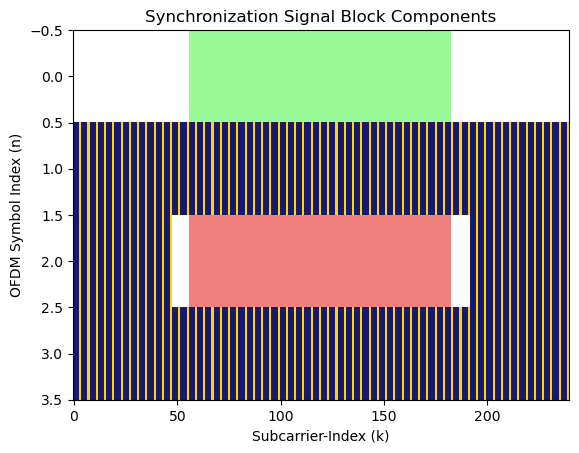
3. Construct Transmission Grid and Generate Time Domain Samples
[11]:
## Loading SSB to Resource Grid
numofGuardCarriers = (int((fftSize - Neff)/2), int((fftSize - Neff)/2))
offsetToPointA = 0
firstSCIndex = int(numofGuardCarriers[0] + offsetToPointA)
numOFDMSymbols = ssbGrid.shape[0]
# The transmission grid that will carry SSB and will be OFDM modulated
X = np.zeros((numOFDMSymbols, fftSize), dtype= np.complex64)
X[:, firstSCIndex:firstSCIndex+ssbGrid.shape[-1]] = ssbGrid
# Plot Resource Grid
#################################################################
fig, ax = plt.subplots()
plt.imshow(np.abs(X), cmap = 'hot', interpolation='nearest', aspect = "auto")
ax = plt.gca();
ax.grid(color='c', linestyle='-', linewidth=1)
ax.set_xlabel("Subcarrier-Index (k)")
ax.set_ylabel("OFDM Symbol Index (n)")
ax.set_title("Heat map of Transmit Grid")
# Gridlines based on minor ticks
plt.show()
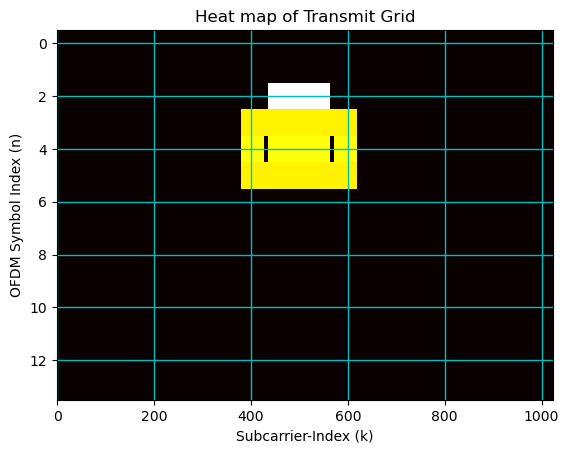
OFDM Modulation
[12]:
# OFDM Modulation at Transmitter
#####################################
modulator = OFDMModulator(lengthCP[1])
x_time = modulator(X).flatten()
3. SDR-Setup Configurations
[13]:
# SDR setup
sdr = adi.Pluto("ip:192.168.2.1") # Create object of SDR setup object and configure the IP of SDR connect to the system
sdr.sample_rate = int(sample_rate) # Sets the sample rate for the ADC/DAC of the SDR.
# Config Tx
sdr.tx_rf_bandwidth = int(sample_rate) # Set the bandwidth of the transmit filter | Can be set same as the sample rate
# For Pluto SDR, tx_rf_bandwidth should be between 200 kHz and 56 MHz.
sdr.tx_lo = int(center_frequency) # Sets the transmitter local oscillator frequency. The carrier is used to modulate/up-convert the analog information signal.
# For Pluto SDR, tx_lo can take a value between 325 MHz to 3.8 GHz.
sdr.tx_hardwaregain_chan0 = 0 # Sets the gain (dB) of the transmitter power amplifier. The higher the value the more the power radiated by antenna.
# For Pluto SDR, tx_hardwaregain_chan0 can take values between -90 to 0.
# Config Rx
sdr.rx_lo = int(center_frequency) # Sets the receiver local oscillator frequency.
# For Pluto SDR, rx_lo can take a value between 325 MHz to 3.8 GHz.
sdr.rx_rf_bandwidth = int(60*10**6) # Set the bandwidth (in Hz) of the reception filter
# For Pluto SDR, tx_rf_bandwidth should be between 200 kHz and 56 MHz.
sdr.rx_buffer_size = int(buffer_size) # Number of samples to read and load into SDR buffer.
# The upper limit on the size of this buffer is defined by the DRAM size.
sdr.gain_control_mode_chan0 = 'manual' # Defines the mode of receiver AGC.
# # AGC modes:
# # 1. "manual"
# # 2. "slow_attack"
# # 3. "fast_attack"
# The receive gain on the Pluto has a range from 0 to 74.5 dB.
sdr.rx_hardwaregain_chan0 = 40.0 # dB, increase to increase the receive gain, but be careful not to saturate the ADC
# Sets the amplification gain (dB) provided by the low noise amplifier (LNA).
# Relevant only when `gain_control_mode_chan0` is "manual".
3. Transmission: SDR RF Transmitter
[14]:
# Start the transmitter
sdr.tx_cyclic_buffer = True # Enable cyclic buffers
sdr.tx(1.3*2**17*(x_time.repeat(1))) # start transmitting
3. Reception: SDR RF Receiver
[15]:
# Clear buffer just to be safe
for i in range (0, 10):
raw_data = sdr.rx()
# Receive samples
rx_samples = sdr.rx()
# # Stop transmitting
# sdr.tx_destroy_buffer()
3. Time Synchronization: Based on PSS Correlation
[16]:
## PSS Detection: Based on time domain PSS Correlation
pssDetection = PSSDetection("largestPeak")
ssboffset = int((fftSize-Neff)/2+ssbRGobject.startingSubcarrierIndices)
pssPeakIndices, pssCorrelation, rN_ID2, freqOffset = pssDetection(rx_samples, fftSize, lengthCP = lengthCP[1],
nID2=None, freqOffset = ssboffset)
# pssPeakIndices: indicates the time/sample indices where time correlation has spikes
# 1. Spikes are computed based on the Input parameters related to peak detector
# pssCorrelation: Returns the correlation plot for the selected cell-ID 2.
# rN_ID2: Detected Cell ID2 by the algorithm
# freqOffset: frequency offset where SSB/PSS was detected.
## PSS Detection Plot
#################################################################
scaleFig = 1.75
fig, ax = plt.subplots(figsize=(30/scaleFig, 15/scaleFig))
ax.plot(pssCorrelation)
ax.vlines(x = pssPeakIndices, ymin = 0*pssCorrelation[pssPeakIndices],
ymax = pssCorrelation[pssPeakIndices], colors = 'purple')
ax.set_ylim([0,np.max(pssCorrelation)*1.1])
ax.set_xlabel("Time Samples Index")
ax.set_ylabel("Amplitude of Time Domain Correlation")
ax.set_title("Amplitude (of Time Domain Correlation) vs Time-samples")
plt.show()
#________________________________________________________________
**(rasterOffset, PSS-ID) (379, 0)
**(rasterOffset, PSS-ID) (379, 1)
**(rasterOffset, PSS-ID) (379, 2)
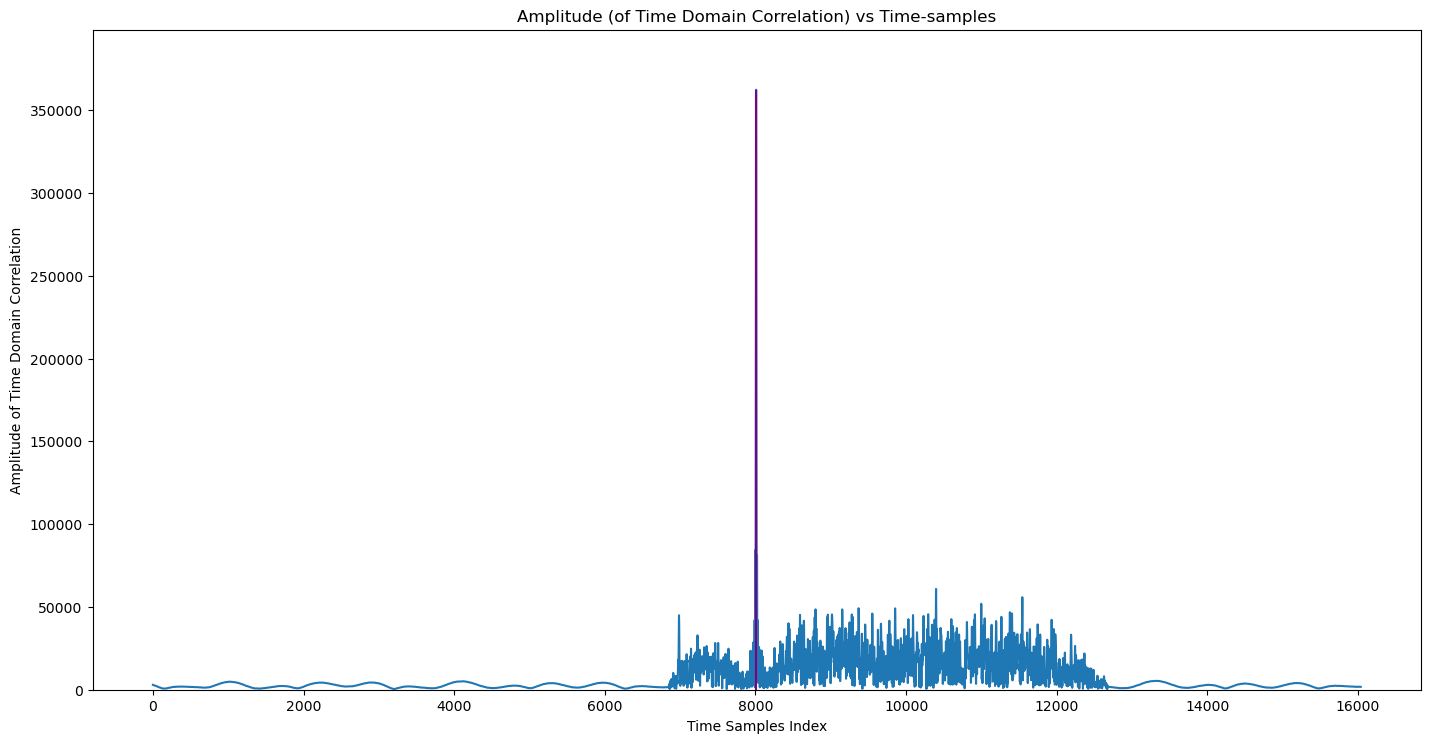
3. Frame Synchronization: Visualization
Note: The following snippet of code only works with interactive maplotlib.
 Please ensure that you have intractive matplotlib installed on your system.
Please ensure that you have intractive matplotlib installed on your system.uncomment the ``%matplotlib widget`` in first code block for the following section of code to work
[17]:
correlation = np.zeros((3, pssCorrelation.size), dtype = np.float32)
r = rx_samples[i:i+fftSize]
correlation[0] = np.abs(np.correlate(rx_samples, np.squeeze(pssDetection.pssRTime[0]), mode='valid'))
correlation[1] = np.abs(np.correlate(rx_samples, np.squeeze(pssDetection.pssRTime[1]), mode='valid'))
correlation[2] = np.abs(np.correlate(rx_samples, np.squeeze(pssDetection.pssRTime[2]), mode='valid'))
# function that draws each frame of the animation
def animate(i):
ax[0].clear()
ax[0].grid()
ax[0].plot(correlation[0,0:scale*(i+1)], color='k', label = "Correlation With PSS with $n_{ID}^{2}=0$")
ax[0].legend()
ax[0].set_xlim([0,pssCorrelation.size])
ax[0].set_ylim([0,np.max(pssCorrelation)*1.1])
ax[1].clear()
ax[1].grid()
ax[1].plot(correlation[1,0:scale*(i+1)], color='g', label = "Correlation With PSS with $n_{ID}^{2}=1$")
ax[1].legend()
ax[1].set_xlim([0,pssCorrelation.size])
ax[1].set_ylim([0,np.max(pssCorrelation)*1.1])
ax[2].clear()
ax[2].grid()
ax[2].plot(correlation[2,0:scale*(i+1)], color='b', label = "Correlation With PSS with $n_{ID}^{2}=2$")
ax[2].legend()
ax[2].set_xlim([0,pssCorrelation.size])
ax[2].set_ylim([0,np.max(pssCorrelation)*1.1])
ax[3].clear()
ax[3].grid()
ax[3].plot(np.real(rx_samples[0:scale*(i+1)]), color='r', label = "real part of received signal")
ax[3].plot(np.imag(rx_samples[0:scale*(i+1)]), color='y', label = "imaginary part of received signal")
ax[3].legend()
ax[3].set_xlim([0,pssCorrelation.size])
ax[3].set_ylim([minX,maxY])
minX = np.min([np.real(rx_samples).min(), np.imag(rx_samples).min()])
maxY = np.max([np.real(rx_samples).max(), np.imag(rx_samples).max()])
# create the figure and axes objects
scaleFig = 1.75
fig, ax = plt.subplots(4,1,figsize=(30/scaleFig, 20/scaleFig))
fig.suptitle('Spectrum of the Received Signal', fontsize=10)
scale = 100
#####################
# run the animation
#####################
# frames= 20 means 20 times the animation function is called.
# interval=500 means 500 milliseconds between each frame.
# repeat=False means that after all the frames are drawn, the animation will not repeat.
# Note: plt.show() line is always called after the FuncAnimation line.
anim = animation.FuncAnimation(fig, animate, frames=int(np.floor((correlation.size-1)/scale)), interval=1, repeat=False, blit=True)
# saving to mp4 using ffmpeg writer
plt.show()
# anim.save("Overall.gif", fps = 10)
# writervideo = animation.FFMpegWriter(fps=60)
# anim.save('Overall.mp4', writer=writervideo)
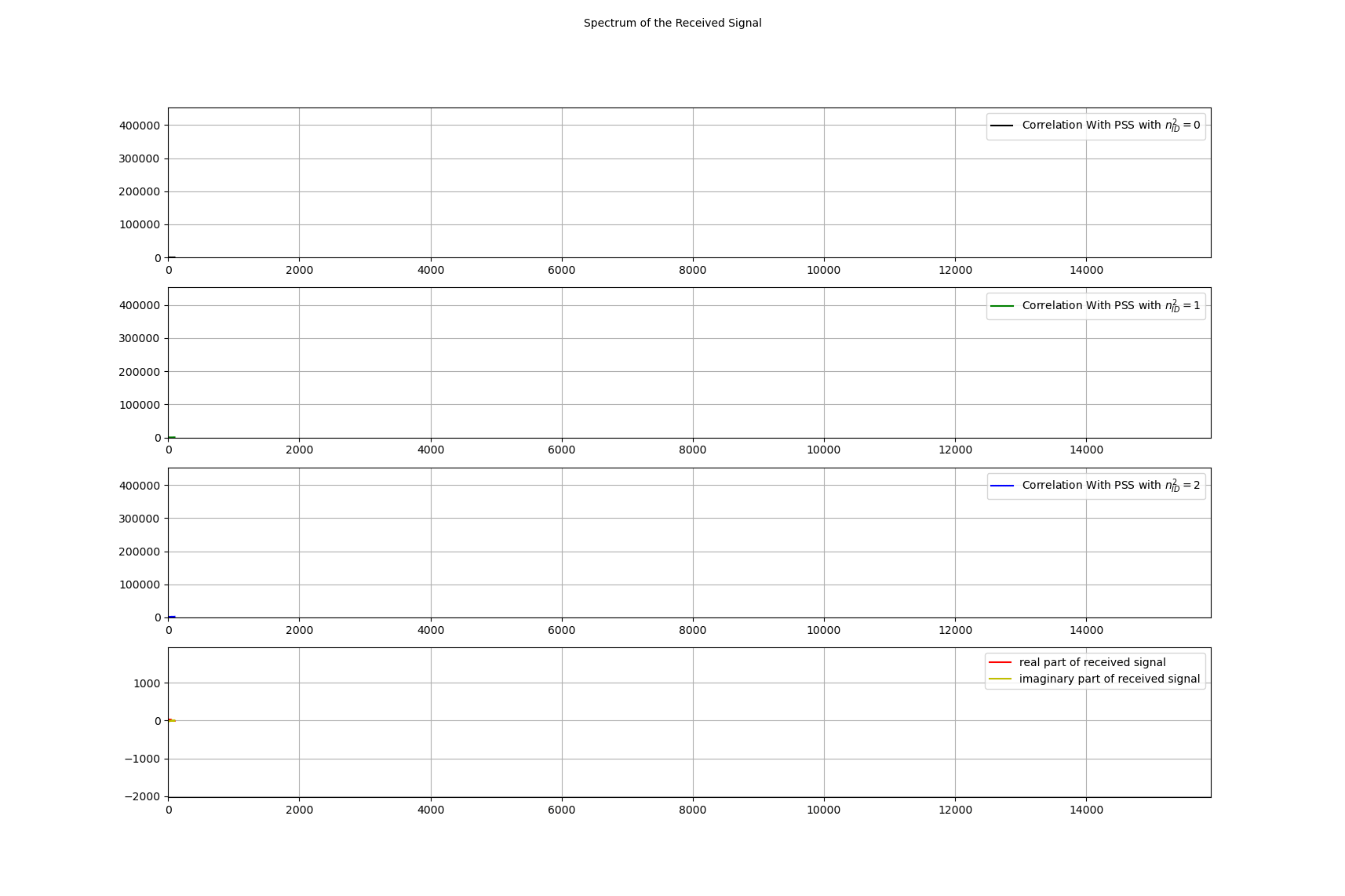
3. Saving Running frames
Note: The following snippet of code only works with interactive maplotlib.
 Please ensure that you have intractive matplotlib installed on your system.
Please ensure that you have intractive matplotlib installed on your system.uncomment the ``%matplotlib widget`` in first code block for the following section of code to work
[18]:
# function that draws each frame of the animation
def animate(i):
if scale*i+fftSize < rx_samples.size:
ax1[3].clear()
ax1[3].grid()
ax1[3].plot(np.arange(scale*i,(scale*i+fftSize)), np.real(rx_samples[scale*i:(scale*i+fftSize)]), color='r', label = "real part of received signal")
ax1[3].plot(np.arange(scale*i,(scale*i+fftSize)), np.imag(rx_samples[scale*i:(scale*i+fftSize)]), color='y', label = "imaginary part of received signal")
ax1[3].legend()
ax1[3].set_xlim([scale*i, scale*i+fftSize])
ax1[3].set_ylim([minX,maxY])
# create the fig1ure and axes objects
scalefig1 = 1.75
fig1, ax1 = plt.subplots(4,1,figsize=(30/scalefig1, 20/scalefig1))
fig1.suptitle('Spectrum of the Received Signal', fontsize=10)
minX = np.min([np.real(pssDetection.pssRTime[0]).min(), np.imag(pssDetection.pssRTime[0]).min()])
maxY = np.max([np.real(pssDetection.pssRTime[0]).max(), np.imag(pssDetection.pssRTime[0]).max()])
ax1[0].plot(np.real(pssDetection.pssRTime[0]), color='k', label = "real part of Time domain PSS with $n_{ID}^{2}=0$")
ax1[0].plot(np.imag(pssDetection.pssRTime[0]), color='r', label = "imaginary part of Time domain PSS with $n_{ID}^{2}=0$")
ax1[0].legend()
ax1[0].set_xlim([0,pssDetection.pssRTime[2].size])
ax1[0].set_ylim([minX,maxY])
minX = np.min([np.real(pssDetection.pssRTime[1]).min(), np.imag(pssDetection.pssRTime[1]).min()])
maxY = np.max([np.real(pssDetection.pssRTime[1]).max(), np.imag(pssDetection.pssRTime[1]).max()])
ax1[1].plot(np.real(pssDetection.pssRTime[1]), color='k', label = "real part of Time domain PSS with $n_{ID}^{2}=1$")
ax1[1].plot(np.imag(pssDetection.pssRTime[1]), color='r', label = "imaginary part of Time domain PSS with $n_{ID}^{2}=1$")
ax1[1].legend()
ax1[1].set_xlim([0,pssDetection.pssRTime[2].size])
ax1[1].set_ylim([minX,maxY])
minX = np.min([np.real(pssDetection.pssRTime[2]).min(), np.imag(pssDetection.pssRTime[2]).min()])
max1Y = np.max([np.real(pssDetection.pssRTime[2]).max(), np.imag(pssDetection.pssRTime[2]).max()])
ax1[2].plot(np.real(pssDetection.pssRTime[2]), color='k', label = "real part of Time domain PSS with $n_{ID}^{2}=2$")
ax1[2].plot(np.imag(pssDetection.pssRTime[2]), color='r', label = "imaginary part of Time domain PSS with $n_{ID}^{2}=2$")
ax1[2].legend()
ax1[2].set_xlim([0,pssDetection.pssRTime[2].size])
ax1[2].set_ylim([minX,maxY])
# fig1.clear()
minX = np.min([np.real(rx_samples).min(), np.imag(rx_samples).min()])
maxY = np.max([np.real(rx_samples).max(), np.imag(rx_samples).max()])
scale = 100
#####################
# run the animation
#####################
# frames= 20 means 20 times the animation function is called.
# interval=500 means 500 milliseconds between each frame.
# repeat=False means that after all the frames are drawn, the animation will not repeat.
# Note: plt.show() line is always called after the FuncAnimation line.
anim1 = animation.FuncAnimation(fig1, animate, frames=int(np.floor((rx_samples.size-1)/scale)-1), interval=1, repeat=False, blit=True)
# saving to mp4 using ffmpeg writer
plt.show()
# anim1.save("Overall_frame.gif", fps = 10)
# writervideo = animation.FFMpegWriter(fps=60)
# anim1.save('Overall_frame.mp4', writer=writervideo)
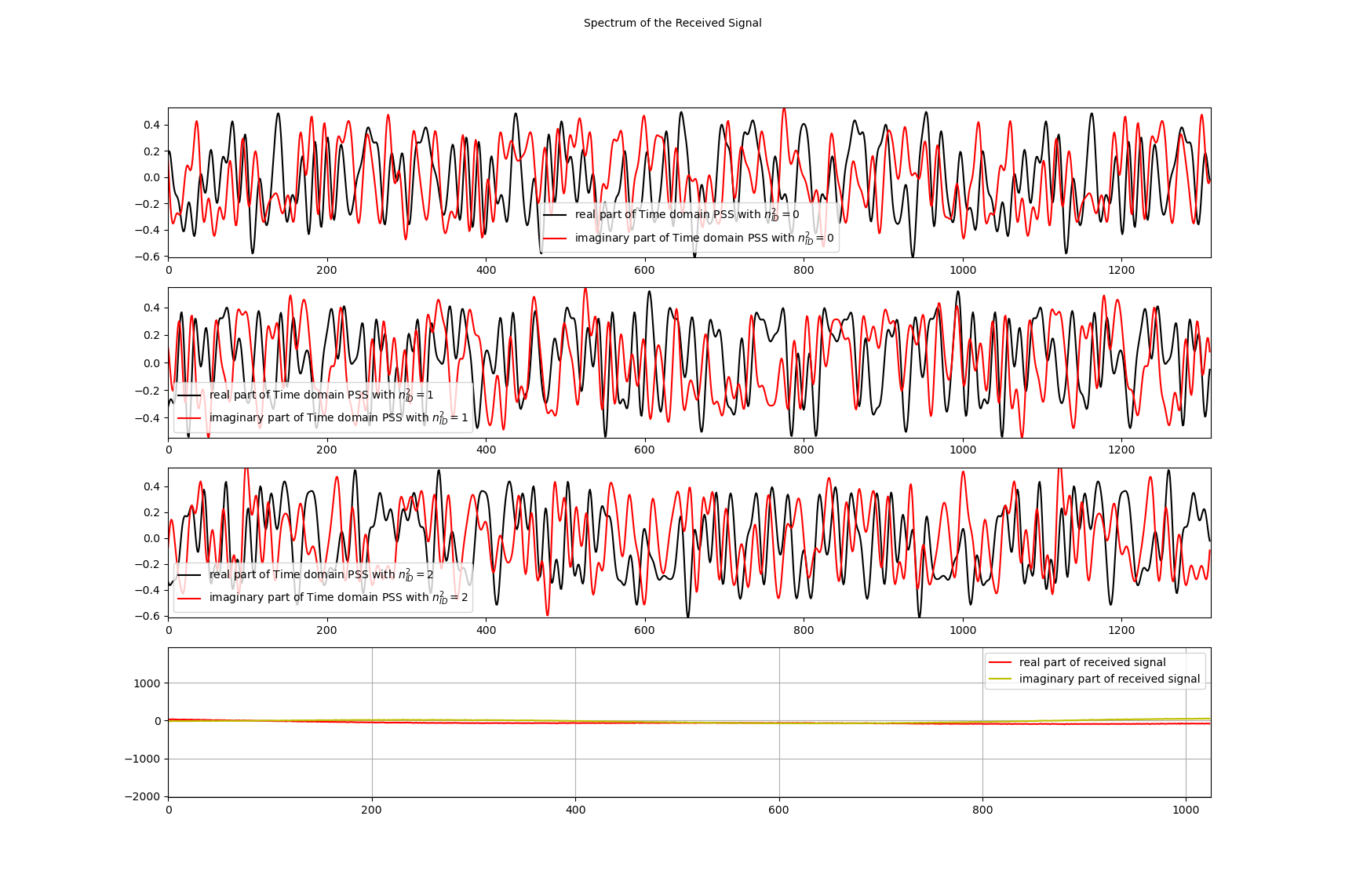
[ ]: